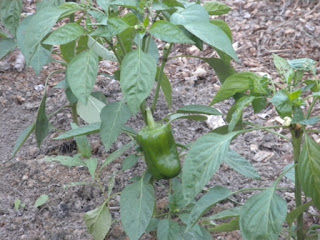 |
| Probably the last week |
Greetings from the Garden! This box has two varieties of lettuce, kale, radicchio, "topless radishes," asparagus, green onions, garlic scapes, snap peas, strawberries, dill, and the first carrots.
Field Notes. Rain. And more rain. I think of the proverb "Be careful what you ask for." Last newsletter I was talking dry, and now after over 3" of rain we are saturated. Optimum garden precipitation is 1" per week. And although the organic matter Ken has built for decades helps with extremes in either drought or heavy rainfall, certain crops suffer. The strawberries this week have more water, less concentrated flavor and significantly less shelf life. And if we get more heat and rain, the rest may just rot. So it goes. It has been a good run this year.
 |
| Celery - soon! |
Ken is working with and around the rain. Although most crops are in, he still has several of the sequential plantings such as broccoli and greens to plant. And with the rain and heat, the next "crop" of weeds has germinated. There are early season weeds and then there are the hot weather weeds. We have seen the first purslane, a hot weather European green that like plantain and dandelions has gone wild.
Ken has also been on maintenance. In addition to cultivating the weeds, Monday evening he was tying up tomatoes in the high tunnel. There are blossoms, and that is exciting for all the tomato lovers. In addition he is moving a pump back and forth from medium tunnel in field to high tunnel nearer the house. Even when it rains, the plants in the greenhouse need watering.
 |
| pickled asparagus and strawberries ready to freeze |
From the Kitchen. It is starting to feel like summer! And with summer comes solid root vegetables like last week's beets and this week's carrots. We also have snap peas in the box. I have a couple favorite recipes around peas. First, peas that are lightly steamed and served with chopped dill and sour cream or a basic white sauce of melted butter flour and milk or cream with salt and pepper - chopped green onions optional. Second a combo of sliced cooked carrots with the shorter cooking time peas - variety in color, flavor, and shapes. I love dill and use it not only with peas and carrots, but also in salad dressing.
We went to a potluck last week, and since there were farmers we had great food and several variations of radishes. My new favorite was sliced radishes in a creamy dill dressing. Emmet shared his dressing recipe - cream or sour cream or yogurt with "good pickle juice" and chopped dill. For those non pickle people I would guess it was a little sweet, some vinegar, some mustard, some onion or garlic, salt and pepper. With the rain and heat we harvested the radishes before they cracked or sent up seed shoots and became woody. Radishes store better without tops, and hence your "topless radishes" this week. Once the weather gets hot, the radishes also get hotter. If you need to back up the bite, slice and salt, set aside for about a few minutes and rinse off the salt.
TWO BIG ANNOUNCEMENTS:
1) Mark your calendars as Harvest day and vegetable pick up moves from Wed July 4th to MONDAY July 2nd
2) The Keppers Annual Garden and Field tour is Sunday July 8th from 2 - 4 pm. Tours and talk will be followed by some garden snacks. RSVP is appreciated so I know how much food to prepare.


















































